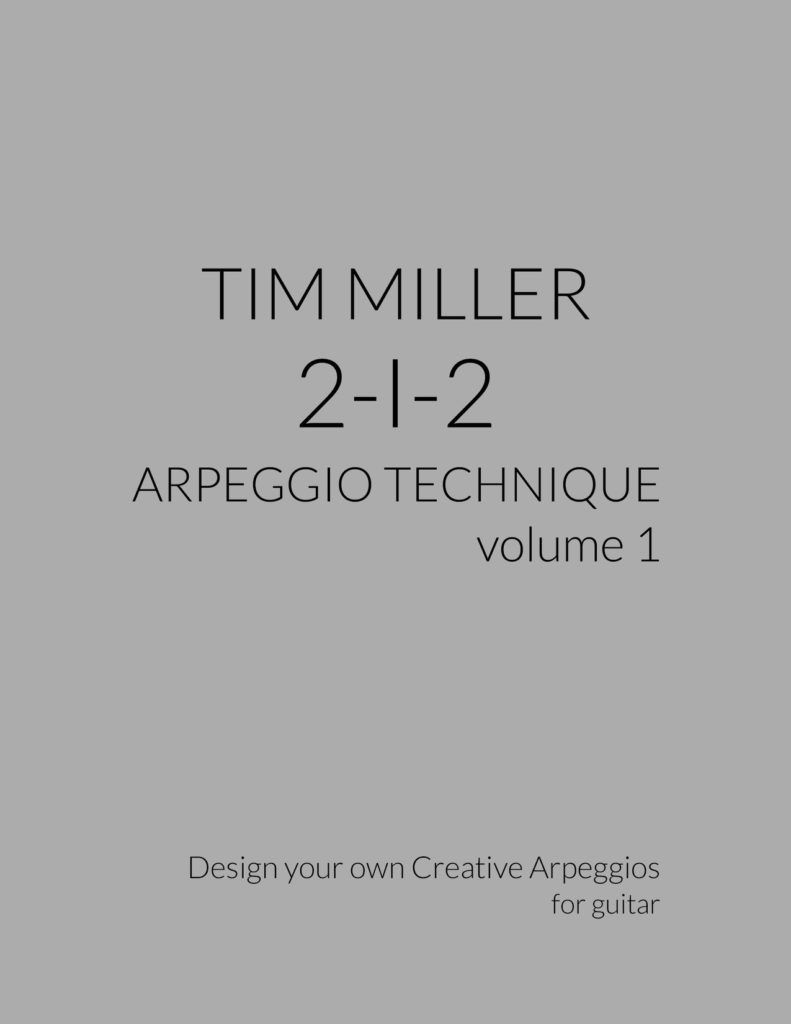
This 250-page book by Tim Miller (a professor at Berklee College of Music) is an important document of his work on 2-1-2 arpeggio technique which he popularized over the years. The basic concept is to play 2 notes on one string, followed by one note on the adjacent string & then back to 2 notes on the following string.
It seems simple enough but the logic and ergonomics of it allow much smoother and faster arpeggio playing. This has been a hallmark of Tim’s playing for years.
For context, I still remember being mesmerized by the sound of his liquid, flowing lines the very first time I heard him play in Berklee. I was a student at Berklee from 2005 to 2007 and Tim was a favorite instructor of many jazz and rock guitar students.
The main attraction was the opportunity to learn Tim’s guitar technique as well as his harmonic approach. I studied with Tim in his guitar lab (a group guitar class) and also took private lessons with him. Both semesters studying with Tim shaped my playing and approach tremendously.
I’ve also been a member of his Tim Miller Music Lessons subscription site (formerly known as Internet Guitar Lessons) which was the main way you could access his knowledge besides taking private lessons with him.
So how does the book compare to those experiences?
Well, firstly the book is definitely has Tim Miller written all over it. It’s very systematic and thoroughly goes through the topic at hand.
It’s an encyclopedic volume with a lot of melodic and harmonic possibilities all written out in standard notation, tablature and fretboard diagrams. This is great as sometimes it’s easier to access the information in one visual format compared to another.
The book shows you how to design your own arpeggios using the basic shapes Tim uses. Then, it goes through four parent scales and their modes: Major, Melodic Minor, Harmonic Minor & Harmonic Major. Finally, it goes through arpeggios that are derived from other scales including Major Pentatonic, Minor Pentatonic, Whole Tone, Whole/Half Diminished, Half/Whole Diminished, Augmented Scales, 9 Note Symmetrical and the Chromatic Scale.
There’s also some tips on Articulation & Tempo at the end of the book.
All in all, this is a very specific kind of book for a specific kind of guitarist. If you enjoy Tim’s playing, then this might be a valuable resource to understand the kinds of arpeggios he uses. If you are bored of playing standard arpeggio shapes, then this might be a good book for you too.
I recommend this for guitarists with an understanding of theory and basic arpeggios. If you’ve never explored standard arpeggio fingerings, this book might be overwhelming with the sheer amount of content provided.
In conclusion, I enjoyed the book for what it is – an insightful volume that shows Tim’s 2-1-2 Arpeggio Technique. If you’re trying to decide whether to buy this or not, do listen or watch some of Tim’s playing for an idea of how this sounds like in a musical situation.
Pros: A great encyclopedic collection of arpeggio shapes that allow you to get creative and unique sounds on guitar.
Cons: The material can be very dry if you’re unfamiliar with how Tim (and other players) use this technique. Also, there are no examples of how to use the arpeggios in context. I look forward to this hopefully being covered in future volumes of this series.
TLDR: If you’re looking for more creative arpeggio sounds for improvising and composing, this book by Tim Miller might be a worthwhile investment.
You can buy this eBook here: https://timmillermusic.com/collections/tim-miller-trio-vol-3/products/212-arpeggio-technique
A physical version is also available on Amazon here: http://amazon.com/Tim-Miller-2-1-2-Arpeggio-Technique/dp/1733209719/
[Review Archive]
I wrote a lot of other book, course and video reviews too.
Check out the rest here:
[Read more reviews]
[Submissions for Review Consideration]
- Are you an author who wrote a jazz, guitar or music book?
- Have you created a DVD or an online video course or subscription based website?
- Would you like me to review your book/course?
Please send me a message at azsamad3 at gmail.com with:
For courses: a link to the course/video/product + access info etc.
For books: a link to the book (Dropbox) or PDF attachment (if it’s small) for review consideration.
Depending on whether I dig the book/course, I’ll let you know if I do plan to review it!
I cannot guarantee a review for every submission & if I’m not too into it, I may opt not to review it. I mean, it’s better to get a good review that for me to write a bad review just because it’s not a match for the kind of stuff I dig right? :p
NOTE: All reviews reflect my honest personal opinion so be aware that I will point out both cool Pros and Cons that I see in the work. You dig?
Thanks for your review, I just bought this book because I was looking for both a FUN and reliable way to continue my scale practice.